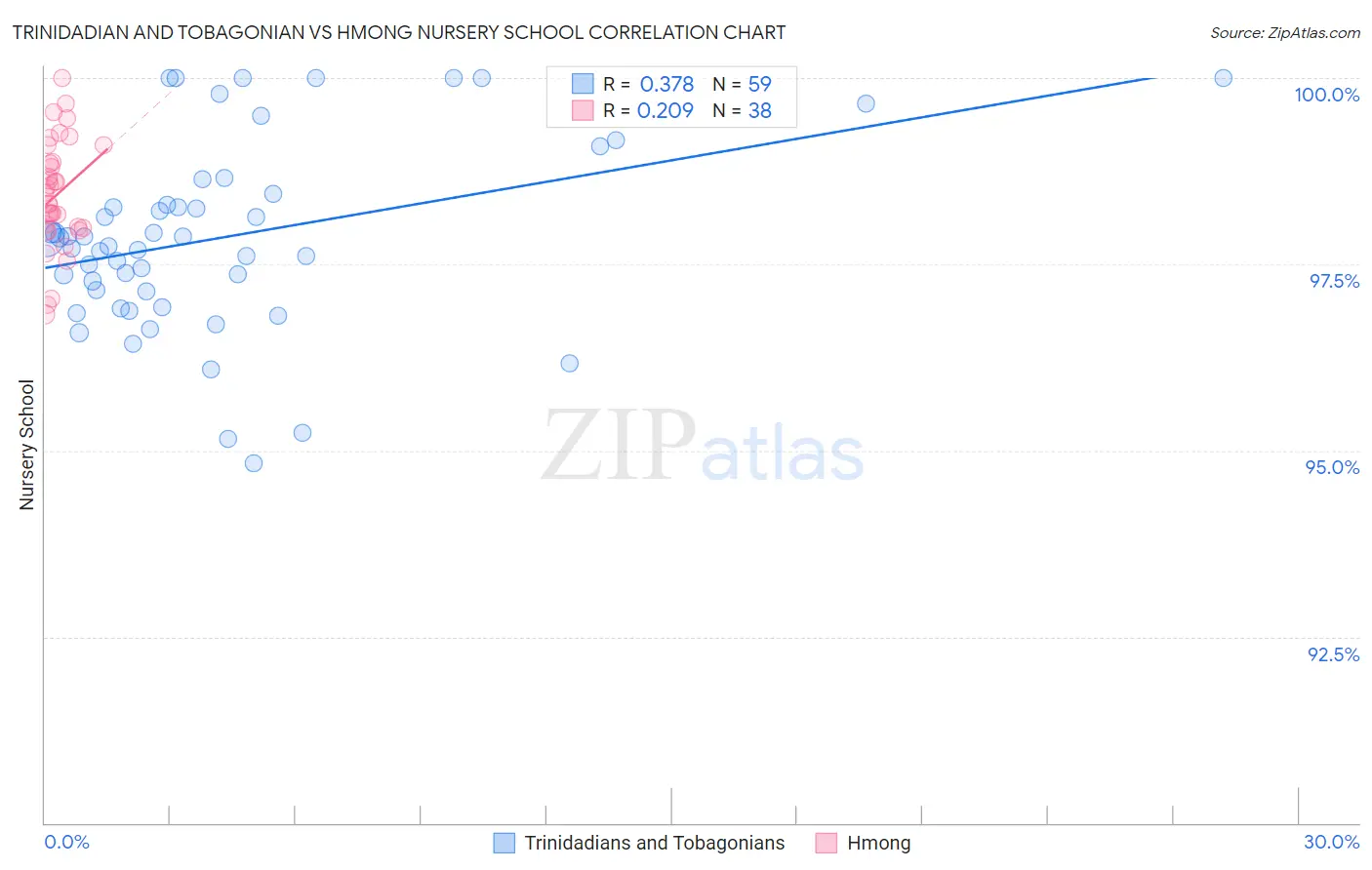Trinidadian and Tobagonian vs Hmong Nursery School
COMPARE
Trinidadian and Tobagonian
Hmong
Nursery School
Nursery School Comparison
Trinidadians and Tobagonians
Hmong
97.4%
NURSERY SCHOOL
0.0/ 100
METRIC RATING
281st/ 347
METRIC RANK
98.1%
NURSERY SCHOOL
75.7/ 100
METRIC RATING
147th/ 347
METRIC RANK
Trinidadian and Tobagonian vs Hmong Nursery School Correlation Chart
The statistical analysis conducted on geographies consisting of 219,882,819 people shows a mild positive correlation between the proportion of Trinidadians and Tobagonians and percentage of population with at least nursery school education in the United States with a correlation coefficient (R) of 0.378 and weighted average of 97.4%. Similarly, the statistical analysis conducted on geographies consisting of 24,672,093 people shows a weak positive correlation between the proportion of Hmong and percentage of population with at least nursery school education in the United States with a correlation coefficient (R) of 0.209 and weighted average of 98.1%, a difference of 0.66%.

Nursery School Correlation Summary
| Measurement | Trinidadian and Tobagonian | Hmong |
| Minimum | 94.8% | 96.8% |
| Maximum | 100.0% | 100.0% |
| Range | 5.2% | 3.2% |
| Mean | 97.9% | 98.4% |
| Median | 97.8% | 98.4% |
| Interquartile 25% (IQ1) | 97.1% | 98.0% |
| Interquartile 75% (IQ3) | 98.4% | 98.9% |
| Interquartile Range (IQR) | 1.3% | 0.87% |
| Standard Deviation (Sample) | 1.3% | 0.73% |
| Standard Deviation (Population) | 1.2% | 0.72% |
Similar Demographics by Nursery School
Demographics Similar to Trinidadians and Tobagonians by Nursery School
In terms of nursery school, the demographic groups most similar to Trinidadians and Tobagonians are Immigrants from Ghana (97.4%, a difference of 0.0%), Barbadian (97.4%, a difference of 0.0%), Afghan (97.4%, a difference of 0.0%), Immigrants from Uzbekistan (97.4%, a difference of 0.010%), and Immigrants from Western Africa (97.4%, a difference of 0.020%).
| Demographics | Rating | Rank | Nursery School |
| Immigrants | Cameroon | 0.1 /100 | #274 | Tragic 97.5% |
| Ghanaians | 0.1 /100 | #275 | Tragic 97.5% |
| Immigrants | Philippines | 0.1 /100 | #276 | Tragic 97.5% |
| Immigrants | Western Africa | 0.1 /100 | #277 | Tragic 97.4% |
| Immigrants | Uzbekistan | 0.1 /100 | #278 | Tragic 97.4% |
| Immigrants | Ghana | 0.1 /100 | #279 | Tragic 97.4% |
| Barbadians | 0.0 /100 | #280 | Tragic 97.4% |
| Trinidadians and Tobagonians | 0.0 /100 | #281 | Tragic 97.4% |
| Afghans | 0.0 /100 | #282 | Tragic 97.4% |
| Immigrants | West Indies | 0.0 /100 | #283 | Tragic 97.4% |
| Immigrants | Trinidad and Tobago | 0.0 /100 | #284 | Tragic 97.4% |
| Immigrants | Barbados | 0.0 /100 | #285 | Tragic 97.4% |
| Immigrants | Portugal | 0.0 /100 | #286 | Tragic 97.4% |
| Immigrants | Hong Kong | 0.0 /100 | #287 | Tragic 97.4% |
| Immigrants | Thailand | 0.0 /100 | #288 | Tragic 97.3% |
Demographics Similar to Hmong by Nursery School
In terms of nursery school, the demographic groups most similar to Hmong are Immigrants from Greece (98.1%, a difference of 0.0%), Immigrants from Israel (98.1%, a difference of 0.010%), Filipino (98.1%, a difference of 0.010%), Apache (98.1%, a difference of 0.010%), and Jordanian (98.1%, a difference of 0.010%).
| Demographics | Rating | Rank | Nursery School |
| Palestinians | 83.7 /100 | #140 | Excellent 98.1% |
| Immigrants | Turkey | 83.0 /100 | #141 | Excellent 98.1% |
| Burmese | 81.7 /100 | #142 | Excellent 98.1% |
| Marshallese | 81.2 /100 | #143 | Excellent 98.1% |
| Alsatians | 80.3 /100 | #144 | Excellent 98.1% |
| Immigrants | Israel | 78.5 /100 | #145 | Good 98.1% |
| Filipinos | 78.5 /100 | #146 | Good 98.1% |
| Hmong | 75.7 /100 | #147 | Good 98.1% |
| Immigrants | Greece | 75.4 /100 | #148 | Good 98.1% |
| Apache | 73.2 /100 | #149 | Good 98.1% |
| Jordanians | 72.9 /100 | #150 | Good 98.1% |
| Soviet Union | 71.6 /100 | #151 | Good 98.0% |
| Dutch West Indians | 70.2 /100 | #152 | Good 98.0% |
| Immigrants | Moldova | 69.6 /100 | #153 | Good 98.0% |
| Immigrants | Iran | 68.7 /100 | #154 | Good 98.0% |